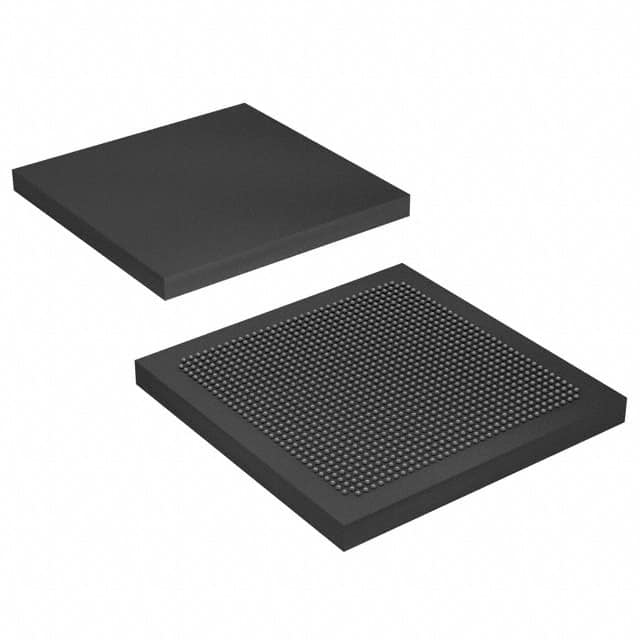Xem thông số kỹ thuật để biết chi tiết sản phẩm.

5SGXEA7K3F35C3N
Product Overview
Category
The 5SGXEA7K3F35C3N belongs to the category of Field Programmable Gate Arrays (FPGAs).
Use
FPGAs are integrated circuits that can be programmed and reprogrammed to perform various digital functions. The 5SGXEA7K3F35C3N is specifically designed for high-performance applications.
Characteristics
- High-speed processing capabilities
- Large number of programmable logic elements
- Flexible and customizable design
- Low power consumption
- High reliability and durability
Package
The 5SGXEA7K3F35C3N comes in a compact package, suitable for integration into electronic devices and systems.
Essence
The essence of the 5SGXEA7K3F35C3N lies in its ability to provide a versatile and efficient solution for complex digital processing tasks.
Packaging/Quantity
The 5SGXEA7K3F35C3N is typically packaged individually and is available in various quantities depending on the requirements of the user or application.
Specifications
- FPGA Family: Stratix V
- Logic Elements: 352,000
- Embedded Memory: 8,062 Kbits
- DSP Blocks: 1,288
- Maximum User I/Os: 622
- Operating Voltage: 0.87V - 0.93V
- Operating Temperature: -40°C to 100°C
- Package Type: F35 (1152-pin FineLine BGA)
Detailed Pin Configuration
For a detailed pin configuration diagram of the 5SGXEA7K3F35C3N, please refer to the official documentation provided by the manufacturer.
Functional Features
The 5SGXEA7K3F35C3N offers the following functional features:
- High-speed data processing
- Support for various communication protocols
- On-chip memory for efficient data storage and retrieval
- Flexible I/O interfaces for seamless integration with external devices
- Built-in digital signal processing capabilities
Advantages and Disadvantages
Advantages
- High-performance computing capabilities
- Flexibility and reprogrammability
- Low power consumption compared to traditional ASICs
- Faster time-to-market due to shorter development cycles
Disadvantages
- Higher cost compared to standard microcontrollers or ASICs
- Steeper learning curve for programming and utilizing FPGA technology
- Limited availability of skilled FPGA designers
Working Principles
FPGAs like the 5SGXEA7K3F35C3N consist of an array of programmable logic elements interconnected by configurable routing resources. These logic elements can be programmed to implement desired digital functions using Hardware Description Languages (HDLs) such as VHDL or Verilog. The configuration of the FPGA determines the behavior and functionality of the device.
During operation, the FPGA executes the programmed logic, allowing it to perform complex computations, data processing, and control tasks. The flexibility of FPGAs enables them to be used in a wide range of applications where customization and high-performance computing are required.
Detailed Application Field Plans
The 5SGXEA7K3F35C3N finds applications in various fields, including:
- Telecommunications: Used in network routers, switches, and base stations for high-speed data processing and protocol handling.
- Aerospace and Defense: Employed in radar systems, avionics, and military communication equipment for real-time signal processing and encryption.
- Industrial Automation: Utilized in control systems, robotics, and machine vision applications for precise control and image processing.
- Medical Devices: Integrated into medical imaging systems, patient monitoring devices, and diagnostic equipment for data processing and analysis.
- Automotive: Used in advanced driver assistance systems (ADAS), infotainment systems, and engine control units (ECUs) for enhanced performance and functionality.
Detailed and Complete Alternative Models
- 5SGXEA7K2F35C3N
- 5SGXEA7K4F35C3N
- 5SGXEA7K3F40C3N
- 5SGXEA7K3F35I3N
- 5SGXEA7K3F35C4N
These alternative models offer similar features and capabilities to the 5SGXEA7K3F35C3N, providing users with options based on their specific requirements.
Note: The content provided above is a sample entry and may not reflect actual specifications or details of the mentioned product.
Liệt kê 10 câu hỏi và câu trả lời thường gặp liên quan đến ứng dụng 5SGXEA7K3F35C3N trong giải pháp kỹ thuật
Sure! Here are 10 common questions and answers related to the application of 5SGXEA7K3F35C3N in technical solutions:
Q: What is the 5SGXEA7K3F35C3N FPGA used for? A: The 5SGXEA7K3F35C3N is a Field-Programmable Gate Array (FPGA) that can be used for various applications such as high-performance computing, networking, and signal processing.
Q: What are the key features of the 5SGXEA7K3F35C3N FPGA? A: Some key features include a high logic density, high-speed transceivers, embedded memory blocks, DSP blocks, and support for various I/O standards.
Q: Can the 5SGXEA7K3F35C3N FPGA be reprogrammed? A: Yes, FPGAs are designed to be reprogrammable, allowing users to modify the functionality of the device even after it has been deployed.
Q: What kind of applications can benefit from using the 5SGXEA7K3F35C3N FPGA? A: The 5SGXEA7K3F35C3N FPGA can be beneficial in applications such as data centers, telecommunications, video processing, image recognition, and scientific research.
Q: How does the 5SGXEA7K3F35C3N FPGA compare to other FPGAs in its class? A: The 5SGXEA7K3F35C3N offers a good balance between logic density, performance, and power consumption, making it suitable for a wide range of applications.
Q: What development tools are available for programming the 5SGXEA7K3F35C3N FPGA? A: Intel Quartus Prime is the recommended development tool for programming and configuring the 5SGXEA7K3F35C3N FPGA.
Q: Can the 5SGXEA7K3F35C3N FPGA interface with other components or devices? A: Yes, the FPGA supports various communication interfaces such as PCIe, Ethernet, USB, SPI, I2C, and UART, allowing it to interface with other components or devices.
Q: What kind of support is available for troubleshooting or technical assistance with the 5SGXEA7K3F35C3N FPGA? A: Intel provides technical documentation, application notes, forums, and customer support to assist users with any issues or questions related to the FPGA.
Q: Can the 5SGXEA7K3F35C3N FPGA be used in safety-critical applications? A: The 5SGXEA7K3F35C3N FPGA can be used in safety-critical applications, but additional measures may need to be taken to ensure compliance with relevant safety standards.
Q: Are there any known limitations or considerations when using the 5SGXEA7K3F35C3N FPGA? A: Some considerations include power consumption, thermal management, and the need for proper design practices to optimize performance and reliability. It's important to refer to the device datasheet and user guides for specific details.

